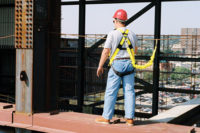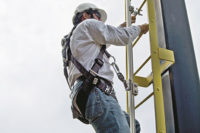Bridging the gap

A number of fall protection challenges exist in bridge construction, including the variety of structure types and materials, the lack of an overhead anchorage point in many situations, multiple workers who must each be outfitted with equipment and tied off, the need for horizontal mobility, narrow walkways and fall clearance concerns. Appropriate selection of anchorage connectors as a part of a complete personal fall arrest system can address all of these challenges.
Anchorage connectors
There are multiple anchorage connector categories with products designed for both steel and concrete, including horizontal lifeline systems, beam anchors, removable concrete and steel anchors, netting systems, tie-off adapters and more.HORIZONTAL LIFELINE SYSTEMS solve many of the fall protection challenges faced in bridge construction. The lack of an overhead anchorage point means that workers must tie off at foot level or create an elevated point. Horizontal lifelines attached to stanchion systems provide an anchorage point at approximately three-and-ahalf feet above foot level. In addition to reducing fall clearance requirements, this elevated cable also provides a handhold for workers moving along narrow walkways. Up to six workers can tie off to a typical horizontal lifeline system, depending on the number of spans (stanchion-to-stanchion segments) and total length of the system. Horizontal lifelines offer the greatest mobility among the anchorage connector options. Most manufacturers offer systems with hands-free bypass capabilities, meaning workers do not need to disconnect from the system to pass intermediate stanchions. This means the worker is protected the full length of the lifeline, which in many cases could span the entire length of the bridge. Horizontal lifeline systems are available for connection to steel I-beams, shear studs, rebar, and concrete.
A word of caution about non-certified horizontal lifeline systems: So-called homemade horizontal systems can be dangerous in the event of a fall. Many of these systems are untested, so the distance a worker will fall is unknown. The cable of a lifeline system will flex during a fall, and homemade systems may not account for this when calculating fall distance. In some cases, the lack of in-line energy absorbing devices can create excessively high forces on the system’s end anchors, resulting in an unacceptably low level of safety. Pre-engineered lifeline systems sold by reliable fall protection manufacturers come with in-line energy absorbers, as well as clearance charts based on the span distance and connective device used, and anchorage point requirements. This will help the contractor comply with regulations and provide a safe fall protection system for workers on bridges.
BEAM ANCHORS that clamp around steel I-beams allow a single user to tie off at foot level. These anchors can be either fixed for stationary work, or they can slide along the beam for increased mobility. When using beam anchors, be certain that the connective device is approved for tying off at foot level. Because this creates a much greater free fall distance, standard shock absorbers will bottom out, exerting dangerous forces on the worker’s body. Connective devices such as shock-absorbing lanyards that allow a 12-foot free fall while keeping forces below OSHA’s limits are a necessity when attached at foot level.
REMOVABLE CONCRETE AND STEEL ANCHORS can also be used during bridge construction and maintenance. These anchors work by drilling a hole into the concrete or steel to create an attachment point, and inserting the anchor, which can be removed and reused in other holes around the job site. These are designed for a single user; however engineered systems can be used with horizontal lifelines for multiple users. Care must be taken so that the worker is not exposed to a fall hazard while switching between connection points.
NETTING SYSTEMS can be used as a passive fall protection system, although more often than not they are used for debris containment. When considering a netting system for personnel fall protection, evaluate the installation time and special installation requirements, the extent of protection the netting would provide, as well as installation costs to determine if netting is an ideal solution for the structure.
TIE-OFF ADAPTERS are more commonly used in the later stages of construction or during inspection and maintenance work. Tie-off adapters and connective devices such as snaphooks and carabiners with large throat openings allow for direct connection onto or around a structural member of the bridge. Designed for one user, they offer only as much mobility as the lanyard or retractable device connected to it.
AERIAL LIFTS AND SUSPENDED SCAFFOLDING may also be appropriate for bridge inspection and maintenance work. On suspended scaffolding, each worker will need a separate lifeline for fall protection that is independent of the scaffold in case of platform failure. Most lifts require connection to the arm or bucket itself to provide the required fall protection.
Other considerations
Anchorage connectors are just one portion of the complete personal fall arrest system. Once the anchorage has been selected, determine what makes sense for the connective device — typically a shock-absorbing lanyard or self-retracting lifeline. The anchorage connector, tie-off location and fall clearance will often dictate which type of connective device to use. Also consider which features are important for the full-body harness, such as multiple D-ring locations, comfort padding, tool belts and other accessories.Other safety considerations during bridge construction and maintenance might include visibility regulations and requirements for working over water. If crews will be conducting hot work such as welding, look into fall protection equipment that is designed to withstand extreme temperatures. Finally, don’t forget about rescue. A versatile mechanical system that attaches to a variety of anchor points and allows the rescuer to raise or lower a fallen worker is an ideal choice.
Looking for a reprint of this article?
From high-res PDFs to custom plaques, order your copy today!




